

Revised Bloom’s Taxonomy – CELT. Jump to the Bloom's Revised Taxonomy Model Go to the Flash version of the Bloom's Revised Taxonomy Model Download the PDF Version A statement of a learning objective contains a verb (an action) and an object (usually a noun).
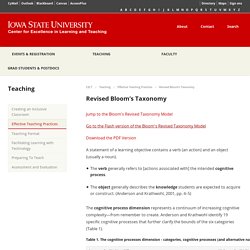
The verb generally refers to [actions associated with] the intended cognitive process. The object generally describes the knowledge students are expected to acquire or construct. The cognitive process dimension represents a continuum of increasing cognitive complexity—from remember to create. The knowledge dimension represents a range from concrete (factual) to abstract (metacognitive) (Table 2). Bloom digital taxonomy v3 01web. Bloom's Taxonomy. The Innovative Instructor. The Innovative Instructor has written about using Facebook in the classroom, what about Twitter?
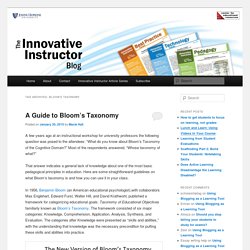
What’s next? You might ask, Pinterest? Yes, even Pinterest seems to have inspired faculty to find uses for its boards in the classroom. Today, however, I want to make a case for using Twitter. What is Twitter? This example of an educational use comes from the CIRTL MOOC, An Introduction to Evidence-Based Undergraduate STEM Teaching, now completed, but due to run again in the near future.
Margaret Rubega, Associate Professor in the Department of Ecology and Evolutionary Biology at the University of Connecticut with a PhD in ornithology, decided to use Twitter, appropriately enough, for her introductory ornithology course. Rebega wanted to get her students to appreciate the way that biology plays out in their world. Thus was born #birdclass.
The second year she taught the course using Twitter, she traveled to Belize during spring break. PadWheel Poster V4 HighRez. Bloom’s Activity Analysis Tool. I have been working on a simple method of analysing teaching and learning technologies against Bloom’s Digital Taxonomy. I have taken the verbs associated with each of the taxonomic levels and arranged them across a sheets and then added a column for the activity components. The idea is that you take your activity and break it down into the component elements and match these against the different taxonomic levels and the learning actions. For example if you looked at students constructing a wiki Editing the wiki is applyingSearching for the information – rememberingTagging the pages with suitable and detailed keywords and notes is understandingValidating the information is evaluatingUploading the resources to the wiki is applyingCollaborating and networking is a higher order skill and so on Here is the PDF version of this tool – blooms-activity-analysis This is a first draft and I would appreciate comments and suggestions.
Action-Words-SLOs-2014-Update.pdf. Blooms Taxonomy Introduction. Writing Objectives Using Bloom's Taxonomy. Various researchers have summarized how to use Bloom’s Taxonomy.
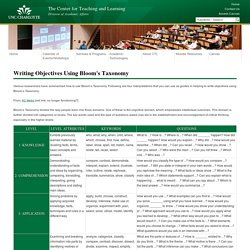
Following are four interpretations that you can use as guides in helping to write objectives using Bloom’s Taxonomy. From: KC Metro [old link, no longer functioning?] Bloom’s Taxonomy divides the way people learn into three domains. One of these is the cognitive domain, which emphasizes intellectual outcomes. This domain is further divided into categories or levels. 14 Bloom's Taxonomy Posters For Teachers. 14 Brilliant Bloom’s Taxonomy Posters For Teachers by TeachThought Staff Bloom’s Taxonomy is a useful tool for assessment design, but using it only for that function is like using a race car to go to the grocery–a huge waste of potential.
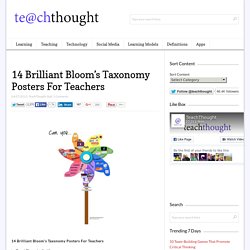
In an upcoming post we’re going to look at better use of Bloom’s taxonomy in the classroom, but during research for that post it became interesting how many variations there are of the original work. While a handful of the charts below only show aesthetic changes compared to others, most are concept maps of sorts–with graphic design that signifies extended function (power verbs), detail (clear explanations), or features of some sort (Bloom’s Taxonomy tasks by level).
The follow simple, student-centered Bloom’s graphics were created by helloliteracy! The following “Bloom’s pinwheel” comes from Kelly Tenkley and ilearntechnology.com: How Colleges Can Better Serve Students with Learning Disabilities. Assistive Technology How Colleges Can Better Serve Students with Learning Disabilities Although assistive technologies and other supports can help, too few students who need them take advantage.
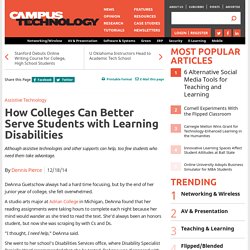
DeAnna Guetschow always had a hard time focusing, but by the end of her junior year of college, she felt overwhelmed. A studio arts major at Adrian College in Michigan, DeAnna found that her reading assignments were taking hours to complete each night because her mind would wander as she tried to read the text. She'd always been an honors student, but now she was scraping by with Cs and Ds. "I thought, I need help," DeAnna said. She went to her school's Disabilities Services office, where Disability Specialist Danielle Ward recommended that she be tested. The results were "phenomenal," DeAnna said. 2 Great Techniques for the Flipped Classroom. Motivate and Engage Online Learners All Semester Long. Online Learning | Feature Motivate and Engage Online Learners All Semester Long These 10 strategies can help keep learners on track to successfully finish your online course.
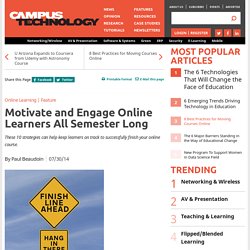
By Paul Beaudoin07/30/14 Recently I remembered the summer when I took swimming lessons with my grandmother. One hot day in July, she asked me to jump off the side of the pool and swim to her. For many learners, taking an online course can be like diving into the pool. Five Ways to Maximize Your Investment in Adaptive Learning. Adaptive learning is a game-changing innovation for higher education.
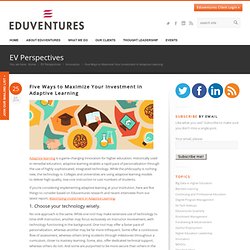
Historically used in remedial education, adaptive learning enables a rapid pace of personalization through the use of highly sophisticated, integrated technology. While the philosophy is nothing new, the technology is. Colleges and universities are using adaptive learning models to deliver high-quality, low-cost instruction to vast numbers of students. If you’re considering implementing adaptive learning at your institution, here are five things to consider based on Eduventures research and recent interviews from our latest report, Maximizing Investment in Adaptive Learning. 1. No one approach is the same. A Periodic Table of Instructional Design. EdTech Tools. Gagne's Nine Events of Instruction. Missouri State U Improves Learning Outcomes with Flipped Classroom. Flipped Classroom | Project Spotlight Missouri State U Improves Learning Outcomes With Flipped Course Missouri State University (MSU) has implemented a flipped classroom model for its Introductory Psychology course, resulting in dramatic improvements in student learning outcomes and course completion rates.
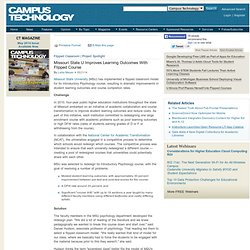
Challenge In 2010, four-year public higher education institutions throughout the state of Missouri embarked on an initiative of academic collaboration and course transformation to improve student learning outcomes and reduce costs. As part of this initiative, each institution committed to redesigning one large enrollment course with academic problems such as poor learning outcomes or high DFW rates (rates of students earning grades of D or F or withdrawing from the course). In collaboration with the National Center for Academic Transformation (NCAT), the universities engaged in a competitive process to determine which schools would redesign which courses.
_Exemplary_Online_Course_Checklist. Bloom's Taxonomy.